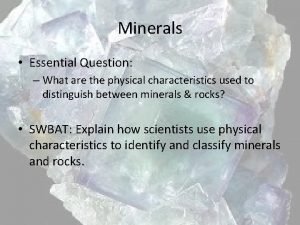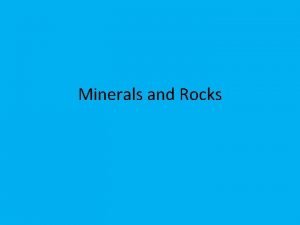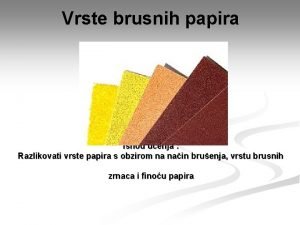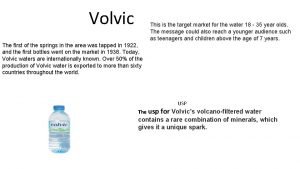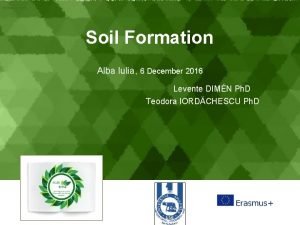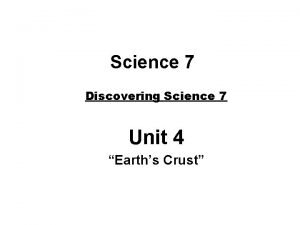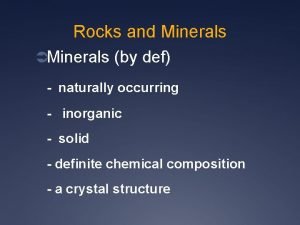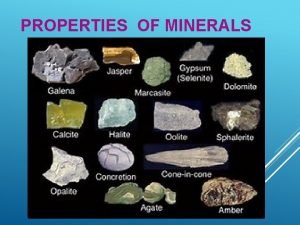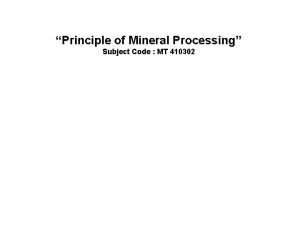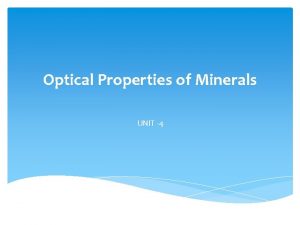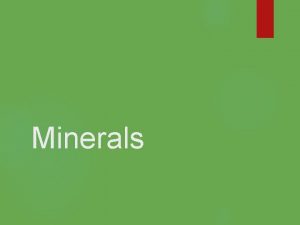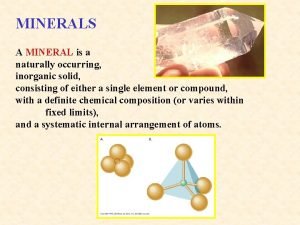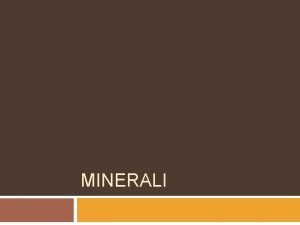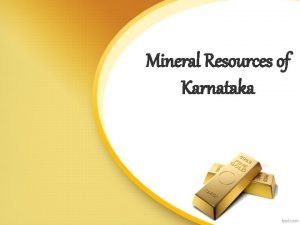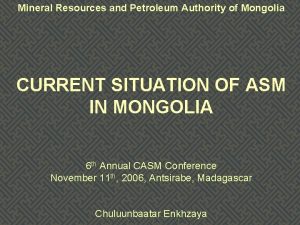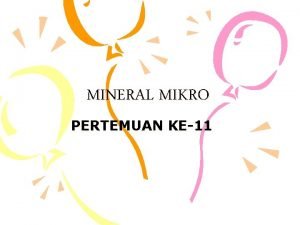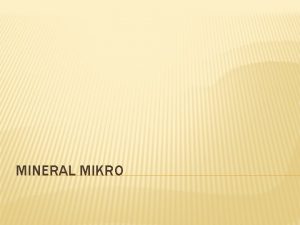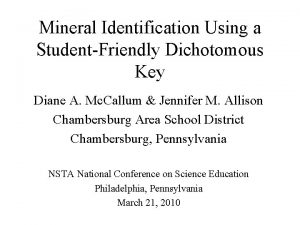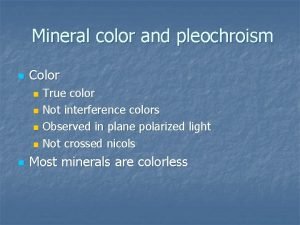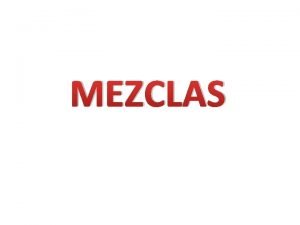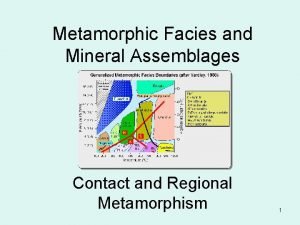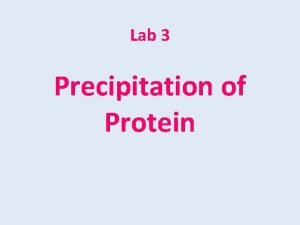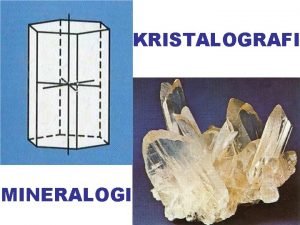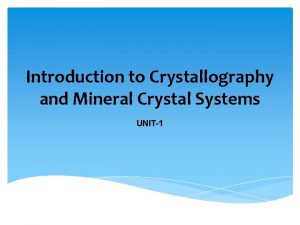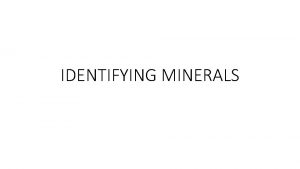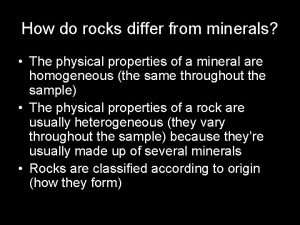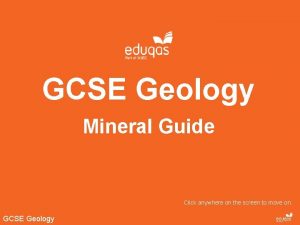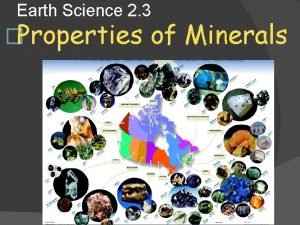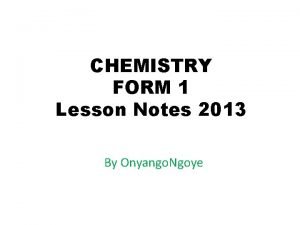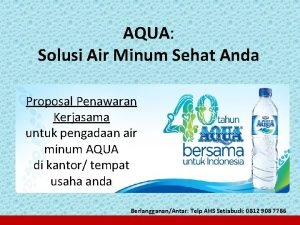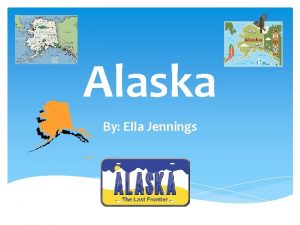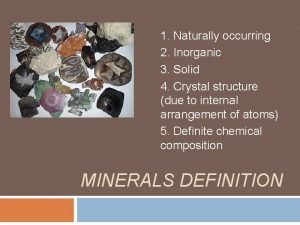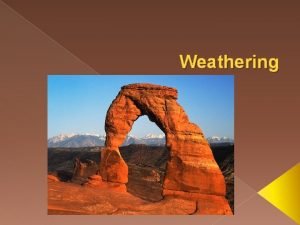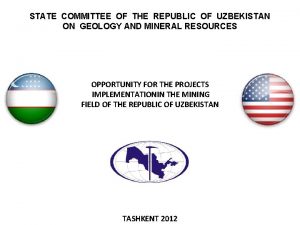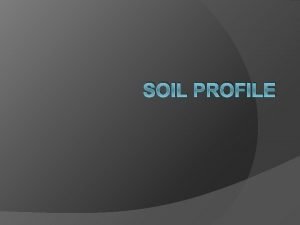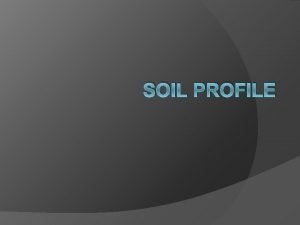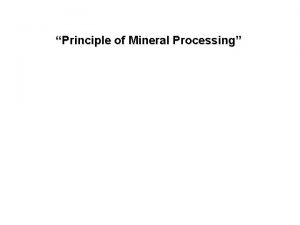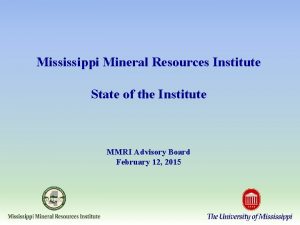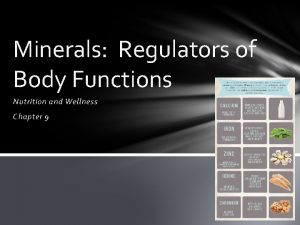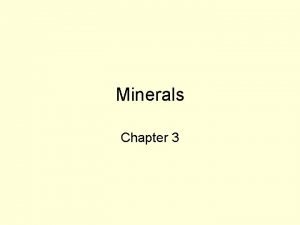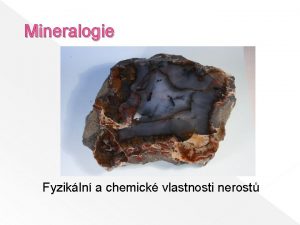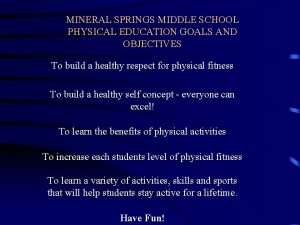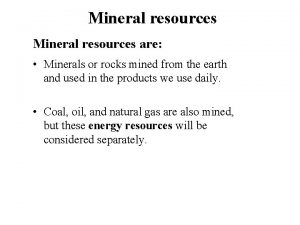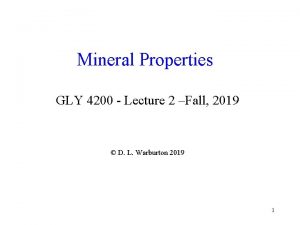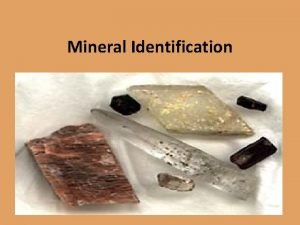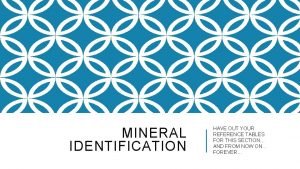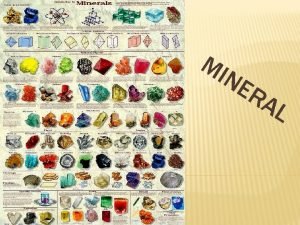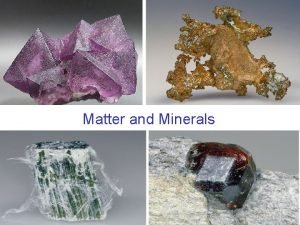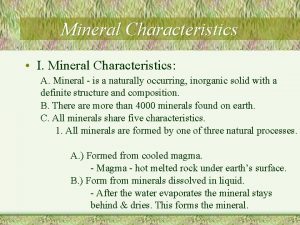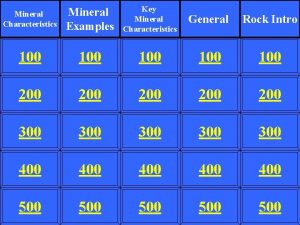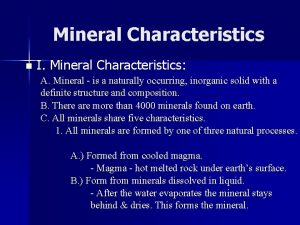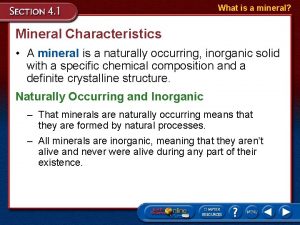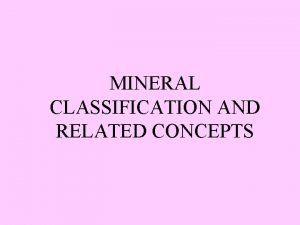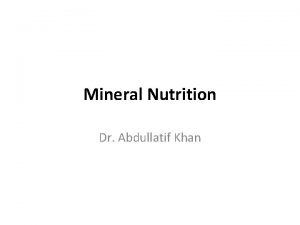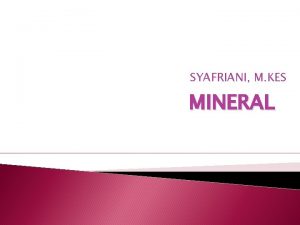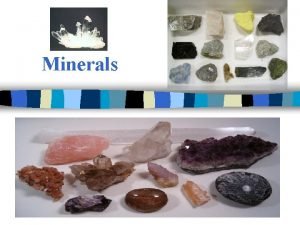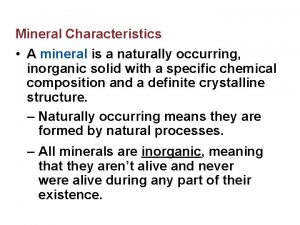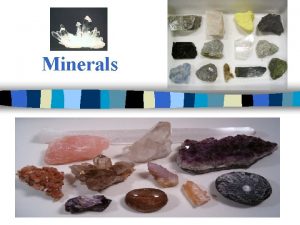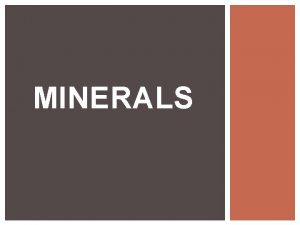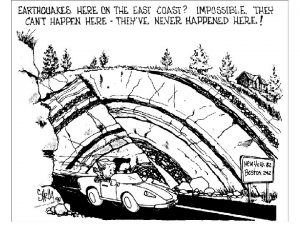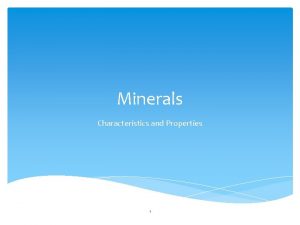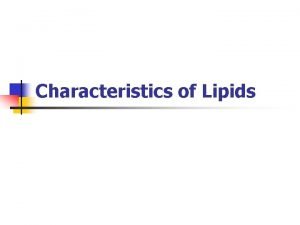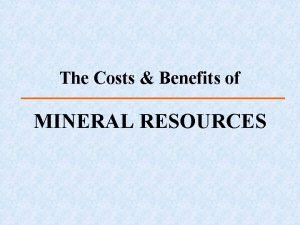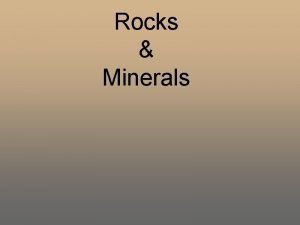What is a mineral Mineral Characteristics A mineral





















































- Slides: 53

What is a mineral? Mineral Characteristics • A mineral is a naturally occurring, inorganic solid with a specific chemical composition and a definite crystalline structure. Naturally Occurring and Inorganic – That minerals are naturally occurring means that they are formed by natural processes. – All minerals are inorganic, meaning that they aren’t alive and never were alive during any part of their existence.

What is a mineral? Mineral Characteristics Definite Crystalline Structure – A crystal is is a solid in which the atoms or molecules are arranged in a definite pattern that is repeated over and over again. There are 6 crystal shapes.

What is a mineral? • Earth’s crust is composed of about 3000 minerals. • Only about 30 minerals are common in Earth’s crust.

What is a mineral? Minerals Formation Minerals form by four major processes: 1. Magma hardening 2. Changes in pressure 3. Changes in temperature 4. Formation of hydrothermal solutions

What is a mineral? Mineral Groups

What is a mineral? Mineral Groups Silicates – Silicates are minerals that contain silicon and oxygen, and usually one or more other elements. – Silicates make up approximately 96 percent of the minerals found in Earth’s crust. – The most common minerals, feldspar and quartz, are silicates. – Ex: Olivine is Mg 2 Si. O 4

What is a mineral? Mineral Groups Carbonates – Carbonates are minerals composed of one or more metallic elements with the carbonate compound CO 3. – Carbonates are the primary minerals found in rocks such as limestone, coquina, and marble. – Ex: Calcite is Ca. CO 3

What is a mineral? Mineral Groups Oxides – Oxides are compounds of oxygen and a metal. – Hematite (Fe 2 O 3) and magnetite (Fe 3 O 4) are common iron oxides and good sources of iron.

What is a mineral? Mineral Groups Sulfates and Sulfides • Sulfates such as anhydrite (Ca. SO 4) are composed of elements with the sulfate compound SO 4. • Sulfides such as pyrite (Fe. S 2) are compounds of sulfur and one or more elements.

Halides • Halides such as halite (Na. Cl) are made up of chloride or fluoride along with calcium, sodium, or potassium.

Mineral Groups Native elements • A native element such as silver (Ag) or copper (Cu) is made up of one element only.

What is a mineral? Mineral Groups

What is a mineral? Section Assessment 1. Match the following terms with their definitions. ___ B mineral ___ C crystal ___ D magma ___ A silicate A. minerals that contain silicon and oxygen, and usually one or more other elements B. a naturally occurring, inorganic solid with a specific chemical composition and definite crystalline structure C. a solid in which the atoms are arranged in repeating patterns D. molten material found beneath Earth’s surface

What is a mineral? Section Assessment 2. What are the two ways that minerals can form from a supersaturated solution? Mineral crystals can precipitate, or drop out of solution if the solution becomes supersaturated. Minerals can also form when liquid evaporates from a supersaturated solution leaving behind the elements which may begin to arrange into crystals.

What is a mineral? Section Assessment 3. Identify whether the following statements are true or false. _______ true There about 30 common minerals in Earth’s crust. _______ false Slowly cooling magma produces small crystals. _______ false Coal is a mineral. _______ true Silicates are the most common minerals on Earth. _______ true Well-defined crystal shapes are rare.


Identifying Minerals Mineral Identification • Geologists rely on several relatively simple tests to identify minerals. • These tests are based upon a mineral’s physical and chemical properties. • It is usually best to use a combination of tests rather than just one to identify minerals.

Mineral Properties • Minerals have certain physical properties that can be used to identify them. -color -luster -hardness -streak -density -crystal shape -breakage -special properties

Identifying Minerals Mineral Identification Color - Color is easy to see but not always reliable because: a. Many minerals have same color b. Color can change.

Identifying Minerals Mineral Identification Streak is the color of powder scraped off a mineral when it is rubbed against a rough hard surface. You can find streak by rubbing a mineral across a piece of unglazed porcelain tile (a streak plate).

Identifying Minerals Mineral Identification Luster – Luster is the way that a mineral reflects light from its surface. – Metallic is shiny like a metal. – Nonmetallic luster might be described as dull, pearly, waxy, or silky.

Crystal Structure • A mineral may be identified by it’s crystal structure, one of the six previously mentioned.

Identifying Minerals Mineral Identification Hardness – Hardness is a measure of how easily a mineral can be scratched. – We use Moh's hardness scale. We use different tools to find the hardness- fingernail, penny, nail, glass plate and streak plate. Diamond, the hardest, is a 10. Talc, the softest, is a 1. – Any mineral with a greater hardness than another mineral will scratch that softer mineral.

Identifying Minerals Mineral Identification Hardness

Identifying Minerals Mineral Identification Cleavage – Minerals break along planes where atomic bonding is weak. – Cleavage is the ability of a mineral to split relatively easily and evenly along one or more flat planes.

Fracture – Fracture is the ability of minerals to break with rough, or jagged edges.

Identifying Minerals Mineral Identification Density and Specific Gravity – Differences in weight are the result of differences in density, which is defined as mass per unit of volume. – Density is expressed as a ratio of the mass of a substance divided by its volume, or D = M/V. – Density reflects the atomic weight and structure of a mineral. – The most common measure of density used by geologists is specific gravity. – Specific gravity is the ratio of the weight of a substance to the weight of an equal volume of water at 4°C.

Identifying Minerals Special Properties • Special properties of minerals also can be used for identification purposes. – A type of calcite called Iceland spar causes light to be bent in two directions, a process known as double refraction, when it passes through the mineral. – Magnetite, an iron ore, is naturally magnetic.

Special Properties – Calcite (Ca. CO 3) fizzes when it comes into contact with hydrochloric acid (HCl).

Identifying Minerals Mineral Uses • Minerals are virtually everywhere. • They are used to make computers, cars, televisions, desks, roads, buildings, jewelry, beds, paints, sports equipment, and medicines, just to name a few uses.

Identifying Minerals Mineral Uses Ores – An ore is a mineral that contains a useful substance that can be mined at a profit. – Examples of ores include Hematite, which contains the element iron and bauxite, which contains the element aluminum.

Identifying Minerals Mineral Uses Mines – Ores are removed by underground mining or from large, open-pit mines. – When a mine is excavated, unwanted rock and dirt, known as waste material, are dug up along with ore. – If the cost of separating the waste material becomes higher than the value of the ore itself, then the mineral will no longer be classified as an ore because it would no longer be economical to mine it. – The classification of a mineral as an ore may also change if the supply of or demand for that mineral changes.

Identifying Minerals Gems • Gems are valuable minerals that are prized for their rarity and beauty. • Gems such as rubies, emeralds, and diamonds are cut, polished, and used for jewelry. • In some cases, the presence of trace elements can make one variety of a mineral more colorful and thus more prized than other varieties of the same mineral.

Identifying Minerals Section Assessment 1. Match the following terms with their definitions. ___ C streak ___ D hardness ___ B cleavage ___ A fracture A. the ability to break with arc-like, rough, or jagged edges B. the ability to split relatively easily along one or more flat planes C. the color of a mineral when it is broken up and powdered D. a measure of how easily a mineral can be scratched

Identifying Minerals Section Assessment 2. How would an oversupply of ore possibly change the mineral’s classification as an ore? If an ore is over supplied, it could drive down prices for the ore. This may create a situation in which it would no longer be economical to mine material, thus the material would no longer be classified as an ore.

Identifying Minerals Section Assessment 3. What is specific gravity? Specific gravity is the ratio of the weight of a substance to the weight of an equal volume of water at 4ºC. It is a common measure of density used by geologists.


Chapter Resources Menu Study Guide Section 4. 1 Section 4. 2 Chapter Assessment Image Bank

Section 4. 1 Study Guide Section 4. 1 Main Ideas • A mineral is a naturally occurring, inorganic solid with a specific chemical composition and a definite crystalline structure. There at least 3000 known minerals in Earth’s crust. • A crystal is a solid in which the atoms are arranged in repeating patterns. The six main crystal systems are cubic, tetragonal, hexagonal, orthorhombic, monoclinic, and triclinic. • Minerals form from magma or from supersaturated solution. Most minerals are formed from the eight most common elements in Earth’s crust.

Section 4. 1 Study Guide Section 4. 1 Main Ideas • Oxygen readily combines with other elements to form a diverse group of minerals, including silicates, carbonates, and oxides. A silica tetrahedron is a three-dimensional shape structured like a pyramid. In a silica tetrahedron one silicon atom attaches to four oxygen atoms. • Other major mineral groups include sulfides, sulfates, halides, and native elements. Native elements such as silver or copper are made of one element only.

Section 4. 2 Study Guide Section 4. 2 Main Ideas • Minerals can be identified based on their physical and chemical properties. The most reliable way to identify a mineral is by using a combination of several tests. • A mineral’s color is generally the result of trace elements within the mineral. Texture describes how a mineral feels, and luster describes how a mineral reflects light. Cleavage and fracture describe how minerals break. • A mineral’s streak, hardness, and density are reliable methods of identification. Special properties of minerals such as magnetism also can be used for identification purposes.

Section 4. 2 Study Guide Section 4. 2 Main Ideas • An ore contains a useful substance that can be mined at a profit. If the cost of mining the ore becomes higher than the value of the ore, then the mineral is no longer classified as an ore. The classification of a mineral as an ore may also change if the supply of or demand for the mineral changes. • Gems are valuable minerals that are prized for their rarity and beauty. Trace elements can make one variety of a mineral more valuable than other varieties of the same mineral.

Chapter Assessment Multiple Choice 1. What special property can be used to help identify the mineral sphalerite? a. It fizzles when it comes in contact with HCl. b. It exhibits double refraction. c. A rotten-egg odor is produced during a streak test. d. It is naturally magnetic. Calcite reacts with HCl. Iceland spar and zircon exhibit double refraction when light is passed through them. Magnetite is naturally magnetic.

Chapter Assessment Multiple Choice 2. A mineral with a metallic luster could be described as ___. a. silky c. pearly b. shiny d. waxy Silky, pearly, and waxy can all be used to describe nonmetallic luster.

Chapter Assessment Multiple Choice 3. Which ore is a source of iron? a. bauxite c. zircon b. rutile d. hematite Bauxite is an aluminum ore. The ore rutile is a source of titanium. Zircon contains no iron.

Chapter Assessment Multiple Choice 4. A silica tetrahedron contains ___ oxygen atoms. a. one c. three b. two four d. A silica tetrahedron is made up of one silicon atom bonded to four oxygen atoms.

Chapter Assessment Multiple Choice 5. Which of the following is an example of native element mineral? a. halite c. copper b. pyrite d. anhydrite A native element mineral is made up of only one element. Halite (Na. Cl), pyrite (Fe. S 2), and anhydrite (Ca. SO 4) all contain more than one element.

Chapter Assessment Short Answer 6. Why are crystals that form in well-defined shaped fairly rare? Most crystals form in restricted space.

Chapter Assessment Short Answer 7. What are the characteristics of minerals? To be a mineral, a material must be a naturally occurring, inorganic solid with a specific chemical composition, and a definite crystalline structure.

Chapter Assessment True or False 8. Identify whether the following statements are true or false. ______ true About 90 known elements occur naturally in Earth’s crust. ______ false Oxides are compounds of oxygen and another gas. ______ false Pyrite has a hexagonal crystal system. ______ true Ores must be mined at a profit. ______ true Rubies are more valuable than diamonds.

Image Bank Chapter 4 Images Tetragonal Cubic Orthorhombic Hexagonal Monoclinic Triclinic

To navigate within this Interactive Chalkboard product: Click the Forward button to go to the next slide. Click the Previous button to return to the previous slide. Click the Chapter Resources button to go to the Chapter Resources slide where you can access resources such as assessment questions that are available for the chapter. Click the Menu button to close the chapter presentation and return to the Main Menu. If you opened the chapter presentation directly without using the Main Menu this will exit the presentation. You also may press the Escape key [Esc] to exit and return to the Main Menu. Click the Help button to access this screen. Click the Earth Science Online button to access the Web page associated with the particular chapter with which you are working. Click the Speaker button to hear the vocabulary term and definition when available.

End of Custom Shows This slide is intentionally blank.
 Characteristics of minerals
Characteristics of minerals Special minerals
Special minerals Tvrdi mineral za brušenje
Tvrdi mineral za brušenje Volvic definition
Volvic definition Mineral vs organic soil
Mineral vs organic soil Discovering science 7
Discovering science 7 Naturally occurring mineral
Naturally occurring mineral Crystal shape
Crystal shape 2 product formula mineral processing
2 product formula mineral processing Resemisasi
Resemisasi Symmetrical extinction of minerals
Symmetrical extinction of minerals Inorganic mineral definition
Inorganic mineral definition Mineral vs element
Mineral vs element Mohsova trdotna lestvica
Mohsova trdotna lestvica Minerals found in karnataka
Minerals found in karnataka Mineral resources and petroleum authority of mongolia
Mineral resources and petroleum authority of mongolia Mineral mikro
Mineral mikro Mineral mikro
Mineral mikro Dichotomous key for rocks
Dichotomous key for rocks True color of mineral?
True color of mineral? Spray fijador es solución coloide o suspension
Spray fijador es solución coloide o suspension Metamorphic
Metamorphic Imágenes de origen inorgánico o mineral
Imágenes de origen inorgánico o mineral Precipitation of proteins by strong mineral acids
Precipitation of proteins by strong mineral acids Sistem kristal gypsum
Sistem kristal gypsum Trapezohedron crystal system
Trapezohedron crystal system Luster of minerals
Luster of minerals Rock vs mineral
Rock vs mineral Mica mineral hardness
Mica mineral hardness What is cleavage in minerals
What is cleavage in minerals Mineral acid examples
Mineral acid examples Chapter 13 mineral resources and mining
Chapter 13 mineral resources and mining Contoh proposal penawaran produk air mineral
Contoh proposal penawaran produk air mineral Mga halimbawa ng yamang mineral na di metal
Mga halimbawa ng yamang mineral na di metal Alaska state nickname
Alaska state nickname Inorganic mineral definition
Inorganic mineral definition Is quartza mineral
Is quartza mineral Uzbekistan mineral resources
Uzbekistan mineral resources Oaebcr
Oaebcr Topmost mineral horizon
Topmost mineral horizon Mineral oil hlb
Mineral oil hlb Sizing in mineral processing
Sizing in mineral processing Mississippi mineral resources institute
Mississippi mineral resources institute Mineral cheat sheet
Mineral cheat sheet The splitting of a mineral along smooth flat surfaces
The splitting of a mineral along smooth flat surfaces Nerost
Nerost Mineral springs middle
Mineral springs middle Is quartza mineral
Is quartza mineral Kaage bangara mineral
Kaage bangara mineral Directions of cleavage
Directions of cleavage Mineral reference table
Mineral reference table Mineral antagonism
Mineral antagonism Fracture mineral properties
Fracture mineral properties Preparation of emulsion
Preparation of emulsion
